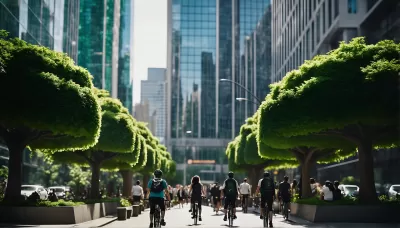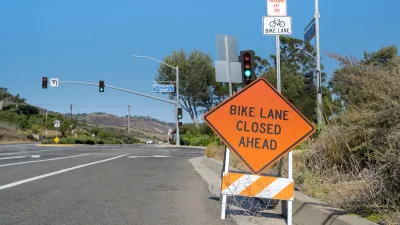Study participants were more likely to support sustainable transportation projects when shown AI images of what the completed real-life infrastructure would look like, suggesting generative AI could be a useful tool for planners.

Researchers in a new study published in Nature showed people AI images of what United States cities would look like with fewer cars and more space for pedestrians, cyclists, and public transit — and people liked what they saw. In fact, they were more likely to support government spending to implement those sustainable transportation policies than people to whom the project and concepts were just described. Petapixel senior news editor Matt Growvcoot explored the study’s results in a recent article.
“The MIT Sloan School of Management presented 3,100 participants with a hypothetical $500 million bill that would replace half of all car lanes in the United States with bus lanes, bike lanes, and wider sidewalks. The subjects were shown a photograph taken from Google Street View showing a cityscape dominated by cars and then three AI alternatives showing how the bill could affect urban environments,” he writes. “The participants who saw the AI illustrations of the city designed for pedestrians rather than cars were more likely to say they would support the fictional bill. Other participants who were simply shown slides with words such as 'greener' and 'bikeable' or rudimentary cartoons of public transport and foliages were less likely to show support for the bill.”
In car-centric America, people have very strong opinions and reactions when planners and policymakers start talking about “taking away” cars, or space from cars. Could AI-generated images be the key to building public support and political will around sustainable transportation projects? This study certainly suggests so. Regardless, it seems like one ethical use of AI-generated images and a potentially valuable AI tool to add to planners’ toolkits.
FULL STORY: People Support Car Bans When Shown AI Images of What Cities Would Look Like

Study: Maui’s Plan to Convert Vacation Rentals to Long-Term Housing Could Cause Nearly $1 Billion Economic Loss
The plan would reduce visitor accommodation by 25,% resulting in 1,900 jobs lost.

North Texas Transit Leaders Tout Benefits of TOD for Growing Region
At a summit focused on transit-oriented development, policymakers discussed how North Texas’ expanded light rail system can serve as a tool for economic growth.

Why Should We Subsidize Public Transportation?
Many public transit agencies face financial stress due to rising costs, declining fare revenue, and declining subsidies. Transit advocates must provide a strong business case for increasing public transit funding.

How to Make US Trains Faster
Changes to boarding platforms and a switch to electric trains could improve U.S. passenger rail service without the added cost of high-speed rail.

Columbia’s Revitalized ‘Loop’ Is a Hub for Local Entrepreneurs
A focus on small businesses is helping a commercial corridor in Columbia, Missouri thrive.

Invasive Insect Threatens Minnesota’s Ash Forests
The Emerald Ash Borer is a rapidly spreading invasive pest threatening Minnesota’s ash trees, and homeowners are encouraged to plant diverse replacement species, avoid moving ash firewood, and monitor for signs of infestation.
Urban Design for Planners 1: Software Tools
This six-course series explores essential urban design concepts using open source software and equips planners with the tools they need to participate fully in the urban design process.
Planning for Universal Design
Learn the tools for implementing Universal Design in planning regulations.
City of Santa Clarita
Ascent Environmental
Institute for Housing and Urban Development Studies (IHS)
City of Grandview
Harvard GSD Executive Education
Toledo-Lucas County Plan Commissions
Salt Lake City
NYU Wagner Graduate School of Public Service





























